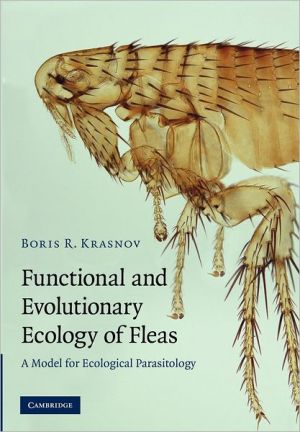

 |

|

Sold Out
Book Categories |
Preface ix
Brief descriptive ecology: what do fleas do?
Composition of the order 3
Infraorders and families 3
Temporal pattern of discovery of flea species 4
Hosts of Siphonaptera 9
Avian and mammalian hosts 9
'Realized' and available hosts 10
Number of flea species among host orders 15
Fleas, small mammals and biogeography 16
Concluding remark 17
Geographical distribution of fleas 18
General patterns of geographical distribution 18
Fleas on islands 21
Size of geographical range 22
Relationship between flea and host(s) geographical ranges 25
Concluding remark 28
Origin and evolution of fleas 29
Ancestral and sister taxa 29
Origin of flea parasitism 32
Phylogenetic relationships within Siphonaptera 33
Cophylogeny of fleas and their hosts 34
Flea diversification: intrahost speciation, host-switching or climate? 41
Concluding remarks 44
Life cycles 45
Mating and oviposition 45
Larvae 48
Pupae 51
Imago 52
Seasonality 54
Concluding remark 67
Fleas and humanity 68
Medical aspects 68
Veterinary aspects 72
Fleas in human habitats 74
Concluding remarks 76
Functional ecology: how do fleas do what they do?
Ecology of sexual dimorphism, gender differences and sex ratio 79
Sexual dimorphism 79
Physiological gender differences 82
Gender differences in behaviour 90
Gender differences in responses to environmental factors 91
Sex ratio as an ecological consequence of gender differences 93
Concluding remarks 102
Ecology of flea locomotion 103
On-host locomotion 103
Off-host locomotion 104
Concluding remark 114
Ecology of host selection 115
Evolutionary scale: principal and auxiliary hosts 116
Ecological scale: host selection 122
Fleas and the ideal free distribution 130
Distribution of fleas on the body of a host 141
Time spent on- and off-host 147
Concluding remarks 153
Ecology of haematophagy 154
Mouthparts and host skin 154
Measures of feeding success 156
Host-related effects 162
Flea-related effects 173
Environment-related effects 178
Concluding remarks 181
Ecology of reproduction and pre-imaginal development 182
Measures of reproductive success 182
Host-related effects 185
Flea-related effects 199
Environment-related effects 206
Concluding remarks 216
Ecology of flea virulence 217
Host metabolic rate 218
Host body mass and growth rate 223
Host haematological parameters 227
Host features related to sexual selection 228
Host behaviour 229
Host survival 232
Host fitness 235
Concluding remarks 237
Ecology of host defence 239
First line of defence: avoidance 240
Second line of defence: repelling or killing fleas 243
Third line of defence: immune response against fleas 255
Concluding remarks 278
Evolutionary ecology: why do fleas do what they do?
Ecology and evolution of host specificity 283
Measures of host specificity 283
Variation in host specificity among flea species 285
Host specificity and evolutionary success 295
Host specificity and host features 303
Evolution of host specificity: direction, reversibility and conservatism 308
Applicative aspects of host specificity studies 314
Concluding remarks 320
Ecology of flea populations 321
Measuring abundance and distribution 322
Is abundance a flea species character? 324
Aggregation of fleas among host individuals 328
Biases in flea infestation 338
Relationship between flea abundance and prevalence 352
Factors affecting flea abundance and distribution 356
Concluding remarks 374
Ecology of flea communities 375
Are flea communities structured? 377
Local versus regional processes governing flea communities 386
Inferring patterns of interspecific interactions 391
Negative interspecific interactions 401
Similarity in flea communities: geographical distance or similarity in host composition? 405
Concluding remarks 408
Patterns of flea diversity 410
Flea diversity and host body 411
Flea diversity and host gender 415
Flea diversity and host population 415
Flea diversity and host community 417
Flea diversity and host geographical range 424
Flea diversity and the off-host environment 425
Flea diversity and parasites of other taxa 431
Concluding remarks 435
Fleas, hosts, habitats 436
The Middle East 437
Central Europe 443
Other examples 451
Concluding remarks 454
What further efforts are needed? 455
Where we are now and what do we have? 456
What do we lack? 458
Not only a pure science... 463
References 466
Index 583
Login|Complaints|Blog|Games|Digital Media|Souls|Obituary|Contact Us|FAQ
CAN'T FIND WHAT YOU'RE LOOKING FOR? CLICK HERE!!! X
 You must be logged in to add to WishlistX
 This item is in your Wish ListX
 This item is in your CollectionFunctional and Evolutionary Ecology of Fleas: A Model for Ecological Parasitology
X
 This Item is in Your InventoryFunctional and Evolutionary Ecology of Fleas: A Model for Ecological Parasitology
X
 You must be logged in to review the productsX
 X
 X

Add Functional and Evolutionary Ecology of Fleas: A Model for Ecological Parasitology, Fleas are one of the most interesting and fascinating taxa of ectoparasites. All species in this relatively small order are obligatory haematophagous (blood-feeding) parasites of higher vertebrates. This book examines how functional, ecological and evolut, Functional and Evolutionary Ecology of Fleas: A Model for Ecological Parasitology to the inventory that you are selling on WonderClubX
 X

Add Functional and Evolutionary Ecology of Fleas: A Model for Ecological Parasitology, Fleas are one of the most interesting and fascinating taxa of ectoparasites. All species in this relatively small order are obligatory haematophagous (blood-feeding) parasites of higher vertebrates. This book examines how functional, ecological and evolut, Functional and Evolutionary Ecology of Fleas: A Model for Ecological Parasitology to your collection on WonderClub |